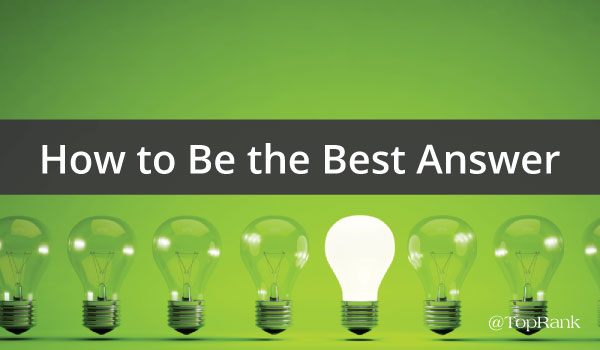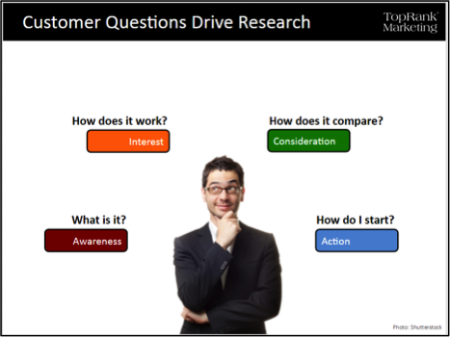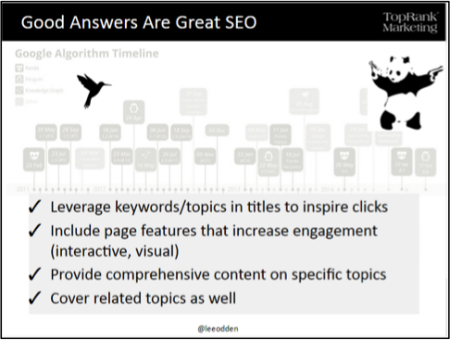
Imagine all the content created from the dawn of recorded history all the way up to 2003. Cave paintings, Renaissance artwork, Egyptian hieroglyphics, sacred texts, romance novels. The whole grand multicultural enchilada.
How long would it take us, in 2016, to replicate that staggering volume of content? According to Google’s Eric Schmidt: 48 hours.
Humanity creates more content every two days than our ancestors managed in 6,000 years. Those slackers.
Sure, that’s an impressive achievement for the human race (quality of the output notwithstanding), but it’s a challenge for every marketer hoping their content finds an audience. With multiple civilizations’ worth of data published every day, how can even the snazziest of infographics earn attention?
TopRank Marketing CEO Lee Odden has spent a decade learning what kind of content stands out from the rest. The solution is simple to say, but complicated to implement: your content must be the best answer to your customers’ questions.
To get the maximum amount of links and shares, to drive long-term search engine results, your content must be the best answer. Not content that showcases your products’ features. Not content that features .gifs of dancing cats (though it couldn’t hurt). Not even content that’s the second-best answer.
So, there you have it. Just be the best answer, and your audience will come to you. Now there’s just one small detail to figure out: How?
Lee tackled this issue in a recent webinar hosted by BuzzSumo Director Steve Rayson. Under Lee’s direction, TopRank Marketing has helped countless clients be the best answer in their respective industries, from small local businesses to Fortune 50 enterprises. You can watch the presentation below, or scroll down for the takeaways.
#1 – It Starts with a Question
Creating great content starts with finding out what questions your customers are asking. There are many ways to get inside your customers’ heads. Lee suggests:
- Asking customers directly through email, surveys, etc
- Asking sales staff what questions they answer every day
- Having customer service CC the marketing department when they answer a question
- Analyzing text from “Contact Us” form submissions
- Using tools like BuzzSumo, Ubersuggest and Huballin
Look for correlations across multiple data sources to build your list of frequently asked questions. Then map them to stages in the buyer’s journey:

#2 – Write Valuable Content to Answer Questions
With your list of questions correlated and prioritized, it’s time to create valuable content that addresses them. Valuable content is:
- Useful and informative. It seeks to answer a question, not bait-and-switch customers into purchasing a product.
- Is your company qualified to answer the question? Do you have a reputation for knowledge in the field? If you need help here, consider partnering with influencers to add credibility.
- High Quality. The best answer tends to be an in-depth exploration of the topic, including related topics where relevant. 5-point blog posts are all well and good, but you can show more value by going in-depth.
- The content is not only relevant and informative, it’s entertaining to read.
- Better than the Competition. Writing content that is better than your competitors’ requires research. Read what others have written on the topic, find unmet needs, and use your content to fill in the gaps.
#3 – Optimize for Humans (which Optimizes for Search Engines)
“Great content isn’t really great until it is found, consumed and shared.” Click to Tweet
While SEO best practices are still important, quality content is the best SEO. When people are compelled to share and link to your content, search engines move you up in their rankings.

The key is to go deep while still being entertaining. Use video and photos to keep readers’ interest. It’s worth investing in the resources to create visual content that pops.
And don’t forget crosslinking: Your comprehensive “best answer” content should link to external, and especially internal, resources that provide more information or offer next steps.
#4 – 10 Elements of Good “Best Answer” Posts
- They’re focused on one specific problem
- They provide social proof with social share count buttons
- They include great visuals & video
- They break it down step-by-step
- They showcase real-life examples, storytelling to boost reader understanding
- They’re informative and entertaining, not one or the other
- They’re serialized to keep audiences in a state of anticipation
- They follow a format that resonates, but with new content each time
- They’re timely, deep resources
- They make a big promise in the title, and actually deliver in the content.
The Ultimate Takeaway:
So what’s the best way to compete with the mountains of content out there? According to Lee: Stop creating content. Just stop.
There has to be more to that quote. Let’s see…Ah, yes:
“Stop creating content, and start making answers relevant to your buyers at each stage.” Click to Tweet
People don’t think, “I need to consume some content about rollerblades before I buy a pair.” Instead, they have questions: What safety equipment should I use with my rollerblades? How durable are different types of rollerblade wheels? How did I get here from 1994 when rollerblading was a thing?”
When you answer these questions with deep, informative, entertaining content, you can earn attention. Continually deliver quality content that speaks directly to your customers’ concerns, problems, and pain points, and you can earn their trust.
Address each part of the buyer’s journey with “best answer” content, and you can gently lead them to the logical conclusion that your solution is what they’ve been searching for.
Want to learn more about content marketing strategy?
Header image via Shutterstock


